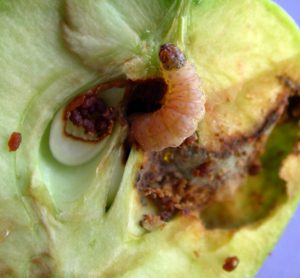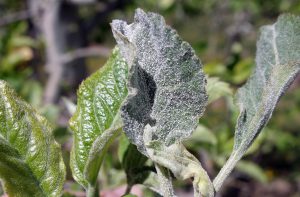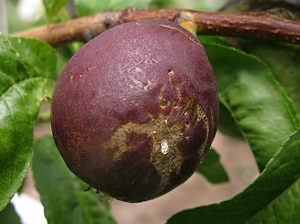In this Issue
- Codling Moth, Washington County
- Prevent Nectarine and Plum Scarring
- Gummosis of Peach/Nectarine, Apricot, Plum
APPLE, PEAR
Codling Moth for Washington County Locations

The Washington County Extension office hung codling moth traps, and tells us that moths were detected in Hurricane. No codling moths have been detected elsewhere, so we only have information for the sites below.
Start treating codling moths on the following dates (see below for treatment options):
- Hurricane: April 27
- Springdale: April 29
- St. George: April 23
For other areas, we will post the information as soon as we know. We are predicting that the timing for the Wasatch Front area will be around the third week of May.
Keep in mind that codling moth is a pest that needs to be prevented all season long for clean fruit. The only non-spray option for clean fruit is to bag them (click here and here for more info on bagging fruit.)
Treatment:
Commercial: Growers should have mating disruption ready to hang in the next few weeks, as apple bloom is just around the corner. Dispensers should be up by full bloom (around the same time as codling moth first flight). Spray options for commercial growers.
Backyard: The table below provides some options for backyard trees. This table is not all-inclusive, but just provides some examples. The products listed are not an endorsement. For the product you decide to use, the “active ingredients” are listed in small print on the lower right or left of the front label. Sometimes there are several ingredients, sometimes, just one. Some materials last longer than others, and the time between sprays is not always listed on the label.
| Product Name | Efficacy | Residual Length (days) | Comments |
|---|---|---|---|
| CONVENTIONAL | |||
| Spectracide Triazicide (gamma-cyhalothrin) | Good to Excellent | 14-17 | wait 21 days to harvest |
| Monterey Bug Buster 11 (esfenvalerate) | Good to Excellent | 14-17 | wait 21 days to harvest |
| Bonide Fruit Tree & Plant Guard (lambda-cyhalothrin) | Good to Excellent | 14-17 | wait 21 days to harvest |
| Bonide Malathion; Hi Yield Malathion | Good | 5-7 | max 2 applications; some products are pears only |
| GardenTech Sevin (zeta-cypermethrin) | Good to Excellent | 14-17 | wait 14 days to harvest |
| ORGANIC | |||
| AzaSol, EcoGarden (azadirachtin) | Good | 7-10 | purchase online |
| Cyd-X (codling moth virus) | Good (if populations are low) | 7 | works best when used at beginning of generation; expensive and purchase online |
| oil such as All Seasons Oil, EcoSmart, Neem oil | Good on eggs only | 3 | recommended for first application of the generation only |
| Ortho Fruit Spray; Fertilome Fruit Tree Spray; Safer End All; Bonide Orchard Spray (all contain pyrethrin) | Good | 3-5 | |
| Monterey / Fertilome Spinosad; Captain Jack's Deadbug Brew; Natural Guard (all contain spinosad) | Good | 10 | max 6 applications per season; if applying to peach or cherry, can re-apply after 7 days |
Apple Powdery Mildew
apply fungicide at open cluster stage and/or at petal fall

The fungus that causes apple powdery mildew overwinters on twigs, and as a result, new infections can occur early in the season. Depending on weather conditions, it can become active at about the tight cluster to open cluster (pink) stage.
If your apples had powdery mildew in the past, treat at open cluster stage (see image), and again after bloom (petal fall). A third treatment 2 weeks later may be required where powdery mildew has been severe in the past.

Commercial growers should be aware that in other parts of the country, powdery mildew fungal populations are becoming increasingly resistant to the Group 3 fungicides (Indar, Procure, Rally, Rhyme). These fungicides have curative effects and are mostly used after mildew has shown up. By using a product from a different fungicide group at the pink stage, use of Group 3 products can be reduced, preventing resistance from occurring in Utah.
Powdery mildew spreads with high humidity, usually in the dawn or dusk hours, and does not need standing water to germinate. When terminal shoots harden off and when relative humidity decreases, new infections slow down.
Some varieties are more susceptible than others (such as Braeburn, Gala, Gingergold, Jonagold, Jonathon, Rome). The Delicious varieties are the least susceptible.
Treatment
Commercial: Options with good to excellent efficacy that are not Group 3 products include Flint, Merivon, Sovran, Fontelis, and sulfur (organic). Click here for more.
Backyard: Spectracide Immunox, Monterey Fungi-Max, Hi Yield Wettable Sulfur (or other sulfur brands; organic), Monterey Complete Disease Control (organic)
PEACH/NECTARINE, APRICOT, PLUM
Prevent Scarring of Nectarine and Plum Fruit
spray right after bloom is over (petal fall), using spinosad

If your nectarine or plum fruits were deformed last year, western flower thrips was the likely cause. It is a tiny insect that feeds on the developing fruit from bloom time to petal-fall.
Spinosad is an organic insecticide made from metabolites produced from soil-dwelling bacteria. It is available in most garden centers and farm supply stores.
Spray at night or early morning because it is harmful to bees when the product is wet (the dry product does not affect bees). Just a single application, with thorough coverage, is needed.
Treatment
Commercial: Entrust (organic), Success
Backyard: Monterey Garden Insect Spray, Natural Guard Spinosad, Bonide Captain Jack’s, and more
